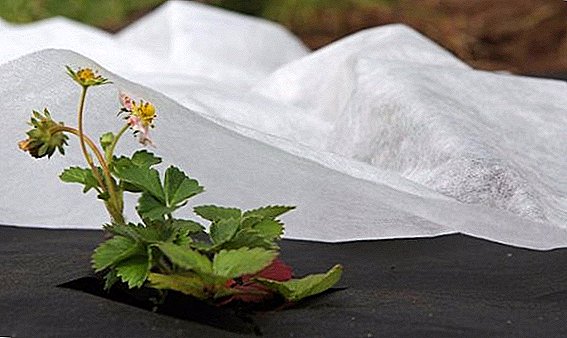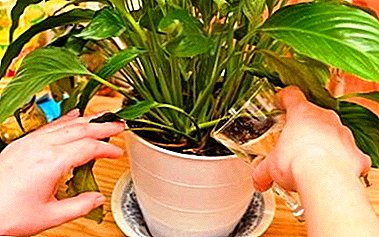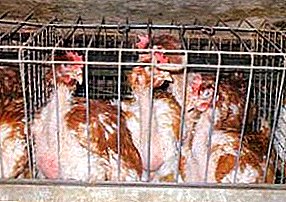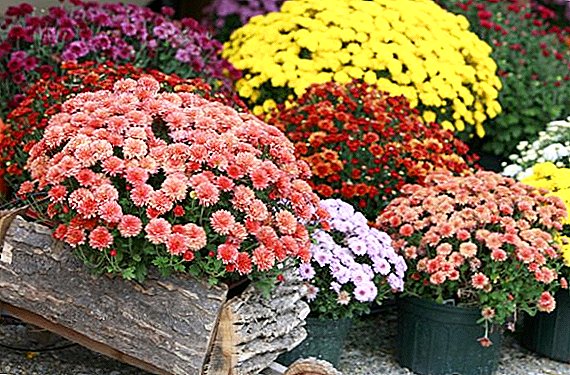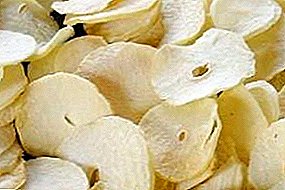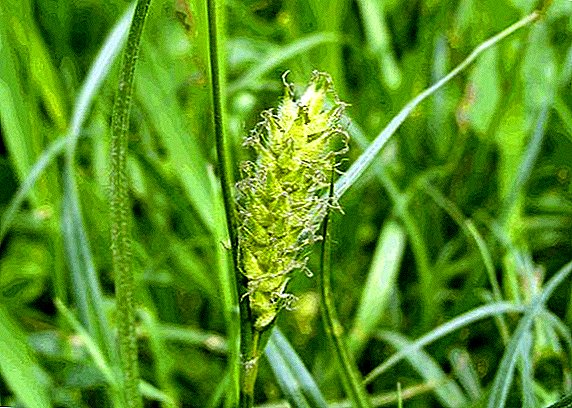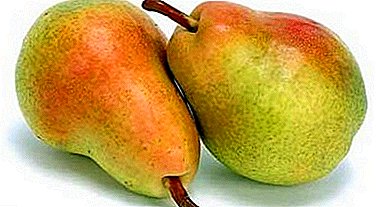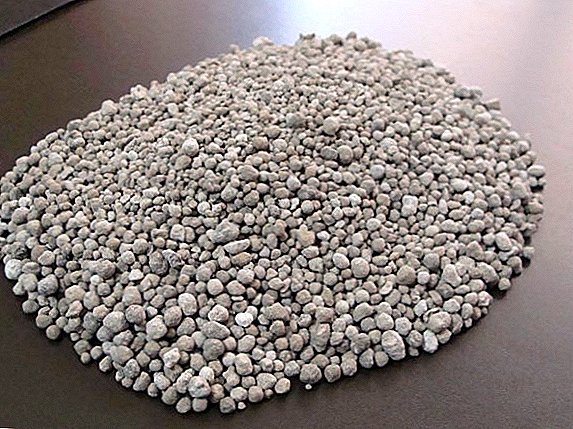 Everyone who grows plants knows that without dressings, there will be no crop, no edible crops, or ornamental crops. Plants do not have enough nutrients in the soil, in addition, not all soils are nutritious, so with the help of fertilizer crops need to be helped. This article will talk about superphosphate its application and properties.
Everyone who grows plants knows that without dressings, there will be no crop, no edible crops, or ornamental crops. Plants do not have enough nutrients in the soil, in addition, not all soils are nutritious, so with the help of fertilizer crops need to be helped. This article will talk about superphosphate its application and properties.
The role of phosphorus in plant development: how to determine the lack of phosphorus
 The role of phosphate fertilizers for plants cannot be overestimated: thanks to this element, the root system of plants is developed and strengthened, the taste characteristics are increased, fruiting is increased and oxidative reactions in plant tissues are reduced. When a plant is sufficiently supplied with phosphorus, it uses moisture more sparingly, the amount of beneficial sugars increases in tissues, the tillering of plants increases, flowering becomes more abundant and fruitful. With sufficient phosphorus, active fruiting, accelerated ripening, high yields are ensured. Thanks to phosphorus, the resistance of plants to disease, to changes in weather conditions, as well as the taste of fruits is increased.
The role of phosphate fertilizers for plants cannot be overestimated: thanks to this element, the root system of plants is developed and strengthened, the taste characteristics are increased, fruiting is increased and oxidative reactions in plant tissues are reduced. When a plant is sufficiently supplied with phosphorus, it uses moisture more sparingly, the amount of beneficial sugars increases in tissues, the tillering of plants increases, flowering becomes more abundant and fruitful. With sufficient phosphorus, active fruiting, accelerated ripening, high yields are ensured. Thanks to phosphorus, the resistance of plants to disease, to changes in weather conditions, as well as the taste of fruits is increased.
Phosphorus for plants - it is a stimulant, it induces the plant to transition from a growth period to flowering, after fruiting, activating all the necessary life processes. Lack of phosphorus reduces the processes of protein synthesis and increases the level of nitrates in plant tissues. The lack of the right amount of element slows growth, the deciduous mass of the plant changes color. With a lack of phosphorus, the plant becomes more susceptible to fungal and viral infections.
What is superphosphate
Consider what phosphate fertilizers. This is a comprehensive balanced composition in the form of powder or granules, used to provide grown crops with all the necessary nutrients. The composition of the fertilizer is divided into groups: simple, double, granulated and ammoniated. The superphosphate contains phosphorus, nitrogen, potassium, magnesium, calcium and sulfur.
When and why use superphosphate
 Phosphorus, one of the main active elements, is involved in all the vital phases of a plant, in metabolic processes in plant tissues, in photosynthesis, in strengthening the immune system and feeding the plant cells. In the soil, even in the most nutritious, there is no more than 1% of phosphorus, even fewer compounds with this element, therefore it is extremely important to fill this deficiency with the help of mineral superphosphate. The use of superphosphate fertilizer becomes mandatory if you notice that the hardwood has darkened, turned blue or rusty. These are signs of a lack of phosphorus, most often this is manifested in seedlings.
Phosphorus, one of the main active elements, is involved in all the vital phases of a plant, in metabolic processes in plant tissues, in photosynthesis, in strengthening the immune system and feeding the plant cells. In the soil, even in the most nutritious, there is no more than 1% of phosphorus, even fewer compounds with this element, therefore it is extremely important to fill this deficiency with the help of mineral superphosphate. The use of superphosphate fertilizer becomes mandatory if you notice that the hardwood has darkened, turned blue or rusty. These are signs of a lack of phosphorus, most often this is manifested in seedlings.
Important! During the hardening period, there may be a reaction to a decrease in temperature, while the plant root system is not able to suck the right amount of phosphorus from the soil. Seedlings are fed with phosphorus, and the processes of growth and development are restored.
Types of superphosphates
Superphosphate has many types, some compounds are enriched with magnesium, boron, molybdenum and other elements. The most used of them will take a closer look.
Did you know? Phosphorus is one of the most important elements of the life of plants, animals, humans and the Earth as a whole. The content of this element in the composition of the earth's crust is 0.09% of its mass, its content in marine waters is 0.07 mg per liter. Phosphorus is present in the composition of 190 minerals, in the tissues of animals and humans, in all tissues and fruits of plants, in organic compounds of DNA.
Plain
 Superphosphate fertilizer simple, or monophosphate, is a gray powder containing up to 20% of phosphorus in the composition. The powder is not caked. However, compared with more advanced types of less effective. Due to the low price, it is widely used by farmers and in industrial agriculture. This fertilizer is applied at a deep digging in the spring and autumn of 50 g per square meter, combining with potash and nitrogen fertilizers. When planting fruit trees make 500 g per well, on the near-stem circle of a growing tree - from 40 to 70 g. For vegetable crops, the rate of application is 20 g per square meter.
Superphosphate fertilizer simple, or monophosphate, is a gray powder containing up to 20% of phosphorus in the composition. The powder is not caked. However, compared with more advanced types of less effective. Due to the low price, it is widely used by farmers and in industrial agriculture. This fertilizer is applied at a deep digging in the spring and autumn of 50 g per square meter, combining with potash and nitrogen fertilizers. When planting fruit trees make 500 g per well, on the near-stem circle of a growing tree - from 40 to 70 g. For vegetable crops, the rate of application is 20 g per square meter.
Double
Double superphosphate is distinguished by the content of highly soluble calcium phosphate in water. This fertilizer contains up to 50% phosphorus, 6% sulfur and 2% nitrogen. The composition is granulated, there is no gypsum in the content. Let's apply on all types of soil and to all cultures. Fertilizer is applied in early spring or autumn. Using this composition, you will improve the quality and quantity of the crop, reduce the ripening period of fruits and berries. In industrial agriculture, double superphosphate is used to increase protein in cereals, and in oil crops - to increase fat. Fertilizer is applied both in spring and autumn in advance, so that before planting or crops, phosphorus is sold in the soil. Plants that are slowed down and weakened are recommended to be watered with a liquid solution of double superphosphate. Apply this structure to all crops and all types of soil.
Granulated
 Granulated phosphate is produced industrially, rolling into convenient for use granules, wetting the powder composition. The dosage of phosphorus in granular superphosphate is up to 50%, the content of calcium sulfate is 30%. Cruciferous plants especially well respond to the granulated superphosphate. Granular superphosphate is well stored, because it does not crumble, and when applied, it dissipates well. Another advantage: it is poorly fixed in the layers of the soil, which is especially valuable on acidic soils with an increased amount of aluminum and iron. In acidic soil fertilizer contribute, mixing with chalk, increasing its efficiency. Most often, granular superphosphate is used on large agricultural areas.
Granulated phosphate is produced industrially, rolling into convenient for use granules, wetting the powder composition. The dosage of phosphorus in granular superphosphate is up to 50%, the content of calcium sulfate is 30%. Cruciferous plants especially well respond to the granulated superphosphate. Granular superphosphate is well stored, because it does not crumble, and when applied, it dissipates well. Another advantage: it is poorly fixed in the layers of the soil, which is especially valuable on acidic soils with an increased amount of aluminum and iron. In acidic soil fertilizer contribute, mixing with chalk, increasing its efficiency. Most often, granular superphosphate is used on large agricultural areas.
Ammoniated
The main plus of ammoniated superphosphate is that it does not contain gypsum, which is poorly soluble in water. The composition of ammoniated fertilizer, in addition to phosphorus (32%), nitrogen (10%) and calcium (14%), contains 12% of sulfur, up to 55% of potassium sulfate. This superphosphate is valuable for oilseed and cruciferous crops, they have the greatest need for sulfur. This fertilizer is used, if necessary, to normalize the indicators of salts and alkalis in the soil. The main advantage of the ammoniated composition is that it does not oxidize the soil, because the acid reaction is neutralized by ammonia. The effectiveness of this fertilizer is 10% higher than other compounds.
Compatibility with other fertilizers
 The best conditions for the conversion of superphosphate into forms accessible to plants are the soil acidity indicators of 6.2-7.5 pH and temperatures not lower than 15 degrees Celsius. To ensure these conditions and the availability of phosphorus to plants, preliminary soil deoxidation is carried out. Superphosphate interacts well with lime, wood ash and dolomite flour.
The best conditions for the conversion of superphosphate into forms accessible to plants are the soil acidity indicators of 6.2-7.5 pH and temperatures not lower than 15 degrees Celsius. To ensure these conditions and the availability of phosphorus to plants, preliminary soil deoxidation is carried out. Superphosphate interacts well with lime, wood ash and dolomite flour.
Attention! Dissolve the soil in advance: one month before the intended addition of superphosphate.
Increases phosphorus digestibility combined with organic fertilizers: humus, manure and bird droppings.
Instructions for use of superphosphate
The use of superphosphate for plants is recommended in the form of entering into the soil when digging in the fall or when sowing crops. It is also used as a top dressing when growing garden crops, fruit trees and shrubs.
Recommended doses for garden plants:
- in early spring or autumn, when digging, they add from 40 to 50 g per square meter;
- when planting seedlings - 3 g in each hole;
- as a dry top dressing per square meter - 15-20 g;
- for fruit trees - from 40 to 60 g per square meter of the circle of the stem.
Interesting! The discovery of phosphorus is attributed to Hennig Brand - an alchemist from Hamburg. In 1669, the bankrupt merchant, in the hope of improving his financial situation, tried to obtain a philosopher's stone with the help of alchemical experiments. Instead, he discovered a substance glowing in the dark.
How to make a hood of superphosphate
The extract from superphosphate is prepared by many experienced plant growers. This is quite problematic to do, because gypsum, which is present in some types of fertilizer, does not want to be dissolved in water without sediment.
To carry out the procedure successfully, it is recommended to perform the following steps:
- Take a granular formulation and hot water (100 g per liter).
- Stir well and boil for thirty minutes.
- In order not to leave a hint of sediment, strain through dense gauze.
 When applying, note that 100 g of the resulting hood will replace 20 g of dry matter; one square meter of soil can be treated with a hood. The use of superphosphate stimulates the growth of plants, strengthens the aerial parts and the root system, promotes lush flowering and, as a result, abundant fruiting, increases the resistance of plants to diseases. Fertilize your garden and orchard, and the crops you grow will respond with a good harvest.
When applying, note that 100 g of the resulting hood will replace 20 g of dry matter; one square meter of soil can be treated with a hood. The use of superphosphate stimulates the growth of plants, strengthens the aerial parts and the root system, promotes lush flowering and, as a result, abundant fruiting, increases the resistance of plants to diseases. Fertilize your garden and orchard, and the crops you grow will respond with a good harvest.



